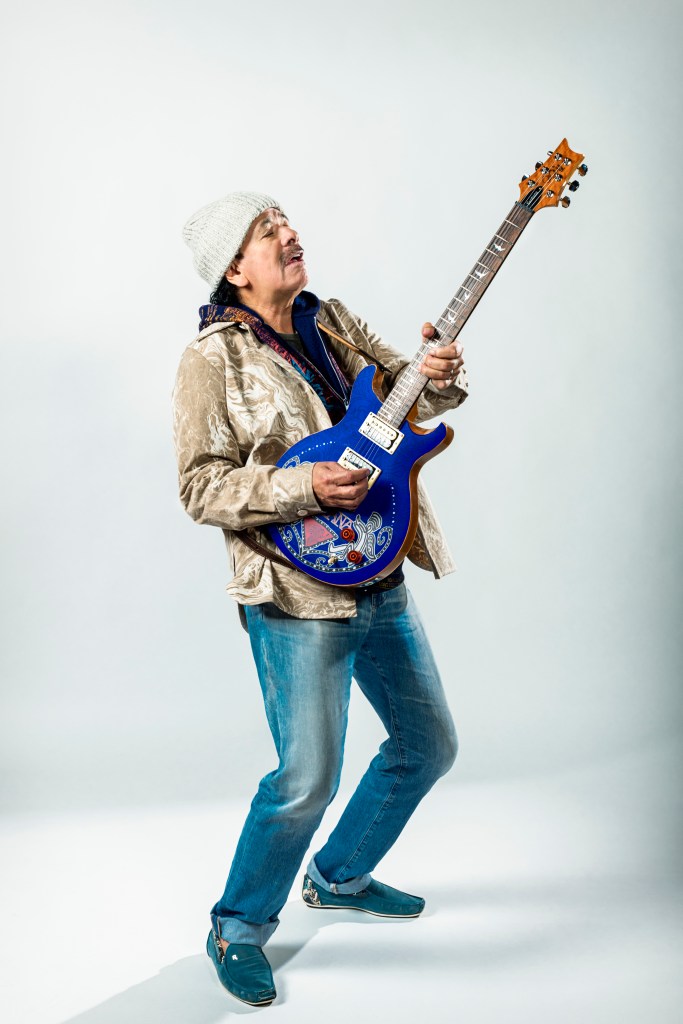“I’m thirsty to dive into the unknown and unpredictability.” —Carlos Santana
Videos by American Songwriter
Carlos Santana is still on fire, figuratively. On a brief sojourn following the heavier isolation of the previous year, the guitarist is back in New York City, reflecting on how he found more clarity and new music. “Who I was before the pandemic, I am 100 times more,” shares the guitarist, ”because I’m more cognizant, and more present and more lucid and more aware that whatever time I got on this planet, I’m going to burn, burn, burn.”
Holding a press conference around his new single “Move,” Rob Thomas, who wrote and sang the mega-hit “Smooth,” off Santana’s album Supernatural, 22 years earlier, is on hand for the “reunion,” albeit virtually, screened in remotely. “Move” is a continuation of what the pair started more than two decades earlier. “I feel very grateful that Rob and I get to reach the four corners of the world again,” says Santana. “At this particular time, the planet has been infected with fear and darkness. People are thirsty for a spiritual jolt, for some inspiration, and some validation and celebration of your own spirit, so we’re moving molecules, atoms, cells. It’s incredible to see how one song can create many vibrations around the world.”
Thomas is part of a collective of artists and the larger vision around Santana’s latest offering Blessings and Miracles.
“Blessings and Miracles is all rooted in the notion that humans are born with an innate power to create both, utilizing the light, spirit, and soul, which are the three main elements of the album,” says Santana. “For me, this album invites people to heal this infection of fear and separation. We create music to bring you courage and a deep awareness of your own life.”

In a time when Santana says fear pervades, Blessings and Miracles is his mystical medicine music. “This is not show business,” he adds. “This is not entertainment. This is mystical medicine music to lift you into a place where your ego cannot bring you into self-deception. The stories I want to share with people are stories of triumph, victory, glory, redemption, forgiveness, compassion, healing, hearing, correcting, and alleviating.”
“Move” was the first burst of musical light. “Our brand is love,” says Thomas, who had opportunities to work with Santana after “Smooth,” but it never felt natural to them. “The idea that 20 some odd years ago, I could do something with a legend just because I wanted to meet him, and for it to become what it did and take on this life of its own and have this shift that went around the world—and then the opportunity to do it again. It just happened naturally and felt right, and that’s what makes this special for me.”
When New York rockers American Authors shared the song they were working on, “Move,” Thomas heard the chorus and immediately sent it to Santana. “When people listen to it, there’s nothing contrived about this,” says Thomas. “There’s nothing that’s in there that has any end goal of success or of anything that we want to come back to us, other than the energy that we put out to everyone else. I think anytime that you can be a part of something that doesn’t have any cynicism attached to it’s a good thing.”
Listening to the song reminds Santana of his deeper bond to Thomas and something that transcends the music itself. “This song comes in and it makes me realize that energy is very welcomed in our hearts because it makes you feel like you’re 17 years old with a lot of thirst for adventure,” says Santana. “When I heard it, I heard Tito Puente and everybody that I love. It’s Spanish Harlem. It’s so amazing that we play music, and that everyone becomes one. That’s what I loved since the beginning since Woodstock. I love when everybody becomes one like Bob Marley said ‘One Love.’”
Santana adds, “Once that happens, there’s no conflict. There’s no division, separation, and fear and darkness disappear. It’s just joy, and with joy, you can create miracles and blessings.”
Working mostly remotely with a collection of collaborators, pulling three tracks—“America for Sale,” featuring Metallica guitarist Kirk Hammett and Death Angel singer Mark Osegueda, “Peace, Power” with Corey Glover, and the instrumental “Mother Yes”—from an earlier session with producer Rick Rubin, where the two recorded a marathon of 49 songs in 10 days, Blessings and Miracles was a spiritual experience for Santana, working with more than half of the artists he’s never met before. Inciting lyrics, envisioning the sentiments, and working his guitar around the stories delivered to him.
“The word is trust,” says Santana. “They trust me, and I trust them and together we create. It was orchestrated inwardly with divine intelligence. It seems like I just show up with a guitar and say, ‘Okay, I want to do this. Thank you for bringing your spirit, your soul, your life and sharing them with us.’”
Reciting a more biblical verse, Surely He will cover me with His feathers under His wings ’til I rest, flying on the wings of angels, to Chris Stapleton, Santana’s words stuck with the country artist long after their conversation to single “Joy.” “He took the components of our conversation and he put in reggae, a gospel choir, and country, but for me, it’s a celebration. I want life to be a celebration. People say, ‘What are you celebrating?’ We need to validate and celebrate the life that makes the molecules stay together, making wishes come true. We created this album to remind people you must take time to validate, celebrate, [and] activate your divine divinity.”
Singing the “Joy” lyric flying on the wings of angels on the phone during a later interview, Santana adds, “After all the words and all the this and that, when I walk away from Supernatural, or Blessings and Miracles, I just hear the guitar going.”

Wanting to recruit longtime friend Steve Winwood, Santana caught the singer/songwriter at the side of the stage at Hyde Park in London, watching Gary Clark Jr., and suggested they cover Procol Haram’s 1967 song “Whiter Shade of Pale”—but more Spanish Harlem style. “I wanted to put some real sex in it,” says Santana, who wanted Winwood’s voice for this track and no other. “He wouldn’t look at me, he just kept looking forward, and then he said ‘I hear it.’ There are some people that when they sing, you hear everybody that we love—you see Ray Charles. I met Stevie Winwood when he was just a child, and he sounds the same. He’s got this voice of eternal presence.”
Pairing up with Diane Warren and G-Eazy on “She’s Fire,” Santana kept much of Blessings and Miracles in the family with his touring band—drummer and wife Cindy Blackman Santana, vocalist Tommy Anthony, bassist Benny Rietveld, percussionist Karl Perazzo, and keyboardist David K. Matthews—along with son Salvador on vocals and keyboards on “Rumbalero,” and lead vocals by daughter Stella, who also shared one of her own songs “Breathing Underwater.”
“They bring their own fingerprints,” says Santana, whose younger daughter Angelica is also working on an album. “They bring their own spirit, their own knowing,” says Santana. “I was so blown away by the way Stella sings, it’s almost like a butterfly kiss. I said, ‘Can I play guitar on your song and put it on my album, and she was like, ‘Are you serious?’ It was the same thing with my son. I heard his song ‘Rumbalero’ from somewhere in the ether and said ‘I can’t stop playing your song. Can I play guitar on it with the band on my album?’ Then there was a long silence and ‘are you serious?’”
Bookending Blessings and Miracles are more spectral instrumentals, the intro “Ghost of Future Pull / New Light” and the closing “Ghost of Future Pull II,” both inspired by Jimi Hendrix’s 1970 release Live at Winterland, and the guitarist’s purer moments feedback. “It was like aurora borealis,” says Santana. “There were stars and constellations and the universe and clouds were singing.”
Reconnecting with friend and collaborator, the late composer Chick Corea wrote the more choral “The Angel Choir,” before he passed away in February of 2021. “My brother Chick Corea and I have been wanting to do an album together since last century,” says Santana. “We finally decided to stop everything and do this song, and as soon as he sent it to me, he transcended.” The track was later executed by Corea’s wife Gayle.
“When I hear Gayle singing doo doo dee dee, it reminds me of a realm that I’ve been before with Alice Coltrane [Illuminations, 1974],” says Santana. “There’s certain music that the music angels and archangels sing around the throne. I feel so blessed, grateful, and overwhelmed with emotion knowing that my brother Chick sent his last song, and we get to share it with the world and touch a lot of people’s hearts.”
Now more than 50 years since his legendary performance at Woodstock and his second album Abraxas, which birthed the witchier brew of “Black Magic Woman” and revived one of his heroes songs—the late Tito Puente’s “Oye Cómo Va”—Santana is still thirsty. At 74, he’s still searching, connecting to what music there is to find.
“Where I am, at 74, my imagination couldn’t be more intense so I can actually just close my eyes, and I know when to come in, how much passion, emotion, and energy to put in a song to make it real,” says Santana. “I just close my eyes, and it’s all happening in real-time anyway.”
He adds, “At that point, it’s a spiritual orgasm. If you’re not getting one, then you’re just going through the motions. You have to resolve and surrender to having that experience because that’s when you lose yourself and you find yourself beyond what you know, or what you learned. I learned a lot of things being a hippie, being around Jerry Garcia. You can’t find yourself unless you lose yourself. It’s important to discard everything that you know, and just present yourself with that willingness to allow purity and innocence to enter your fingers and play those notes.”
Good Energy. That is what keeps Santana’s musical medicinals brewing since forming Santana in the late ’60s. “It’s always new, fresh with fury and innocence,” he says. “A lot of times people get sick of themselves on the radio, and they’re probably playing the wrong thing, or they felt wrong. If you’re playing the right things, you can play it 1,000 times in a row and you’re not going to get tired of it because it’s always welcome. Eternity is always welcome. And eternity is not predictable or redundant.”
Remembering the days during Vietnam when monks would pour gasoline on themselves and light themselves in spiritual protest, is something he relates to metaphorically, to this day.
“That’s what I do,” he says. “I light myself on fire so people can see me for miles, and they can feel it. That fire is called aspiration. I aspire since I can remember to be more than a guitar player or a person. I aspire to be assumed to be a sentient being who makes a difference on this planet. It just happens that I can do it with the guitar.”
Photo Courtesy of Roberto Finizio,
